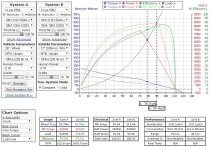trialspower2
100 W
- Joined
- Dec 31, 2016
- Messages
- 108
Hello,
I have built an electric trials bike and custom speed controller with an 120100 outrunner motor. The bike is performing well, however I am looking to further improve it by upgrading it to a 15470 motor. The bike is geared to do around 40mph on 84V, the 120100 is a 50kv motor making around 7A no load current.
With the 15470 outrunner I have two options. I can either get a 50kv motor and keep the current gear ratio, or get a 27kv motor and reduce the reduction ratio. Now I am sure in an ideal world without any losses, at the same voltage and current this would give exactly the same result. But in this application, I am looking for as much torque as possible. Considering the losses inside the motor at low RPM, would it be better to keep with 50kv motor and high gear reduction? As the way I see it in my head, both motors have the same magnets, so this option will likely make more torque?
Or will it follow the theory where both motors have the same rating, so by changing the gearing it will effectively give the same result?
I am also interested in no load current, now in my head I am thinking the lower KV motor will offer a lower no load current, so better efficiency at top speed, but less torque......
I have built an electric trials bike and custom speed controller with an 120100 outrunner motor. The bike is performing well, however I am looking to further improve it by upgrading it to a 15470 motor. The bike is geared to do around 40mph on 84V, the 120100 is a 50kv motor making around 7A no load current.
With the 15470 outrunner I have two options. I can either get a 50kv motor and keep the current gear ratio, or get a 27kv motor and reduce the reduction ratio. Now I am sure in an ideal world without any losses, at the same voltage and current this would give exactly the same result. But in this application, I am looking for as much torque as possible. Considering the losses inside the motor at low RPM, would it be better to keep with 50kv motor and high gear reduction? As the way I see it in my head, both motors have the same magnets, so this option will likely make more torque?
Or will it follow the theory where both motors have the same rating, so by changing the gearing it will effectively give the same result?
I am also interested in no load current, now in my head I am thinking the lower KV motor will offer a lower no load current, so better efficiency at top speed, but less torque......


